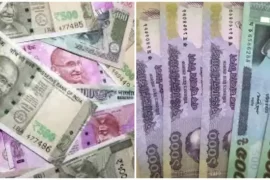In recent times, China and Russia have taken significant steps towards de-dollarizing their economies. De-dollarization refers to the process of reducing the reliance on the US dollar as a means of international trade and investment and moving towards using their own currencies or other alternatives. Let’s examine the reasons behind China and Russia’s de-dollarization efforts, the steps they have taken so far, and their potential implications.

Since the end of World War II, the United States dollar has been the unrivaled king of the financial world. However, with the ongoing Russia-Ukraine conflict, many countries are beginning to explore the possibility of moving away from the dollar for trade purposes. It has raised concerns about the future dominance of the currency.
Reasons for De-dollarization
There are several reasons behind Russia-China de-dollarization initiatives.
America’s weaponization of dollars in response to Russia’s attack on Ukraine is the primary catalyst for the current de-dollarization effort. Russia has been subjected to a series of financial sanctions led by the US. The most significant ones are freezing nearly half of its foreign currency reserves amounting to $300bn and removing major Russian banks from SWIFT. SWIFT is a critical interbank messaging service that enables international payments. These actions have significantly impacted Russia’s ability to conduct international transactions. The country has been exploring alternative financial systems to mitigate the effects of the sanctions.
The US often uses its control over the global financial system as a tool of economic and political influence. Therefore, both China and Russia have been seeking to reduce their vulnerability to such influence. According to The Economist (April 1, 2023), there is a possibility that the US Treasury could attempt to prohibit the utilization of dollars for investing in certain advanced technologies in China.
However, the desire for greater financial independence and reduced dependence on the US-dominated financial system is not new. The dollar’s dominance has been called into question multiple times, including after the collapse of the Bretton Woods system in the 1970s, the launch of the euro by the European Union in 1999, and the 2008-2009 financial crisis. Despite these challenges, the dollar has managed to weather the storms.
Steps towards De-dollarization
Both China and Russia have taken a number of steps towards de-dollarizing their economies.
Chinese initiative
One of the key strategies has been to increase the use of their own currencies in international trade.
China has been encouraging the use of the yuan in trade with its trading partners. It has also been pushing for greater adoption of the currency in international financial markets.
Brazil has started accepting trade settlements and investments in yuan. On March 29, 2023, the two countries announced their plan to trade using their own currencies, instead of the dollar.
The China National Offshore Oil Corporation and France’s TotalEnergies concluded their inaugural trade of liquefied natural gas (LNG) denominated in renminbi on March 28, 2023.
China’s central bank has extended an offer to the Bangladesh Bank for a currency swap agreement. It would permit the use of the renminbi and taka as currencies for pricing and settlement in bilateral trade. Bangladesh’s central bank, in a notification dated September 15, 2022, authorized banks in Bangladesh to hold accounts in Chinese currency for the purpose of making payments in overseas trade.
China and Saudia Arabia have been discussing the possibility of accepting the renminbi as payment for certain oil exports since 2022.
Russian initiative
Similarly, Russia has been promoting the use of the ruble in trade with its partners in the Eurasian Economic Union and beyond.
Dubai-based traders, along with Russian energy companies Gazprom and Rosneft, are attempting to receive non-dollar payments for specific niche grades of Russian oil. These grades of oil have recently been sold above the $60 per barrel price limit. The price limit was clamped last year by the Group of Seven economies, the European Union, and Australia. The intention was to prevent Western services and shipping from trading Russian oil, unless it was sold at a low, enforced price, in order to deny funds to Moscow for its military efforts.
BRICS Initiative
The BRICS alliance has been deliberating the possibility of introducing a new currency. Speculation was rife that this novel financial arrangement might be unveiled during the 15th annual summit held in South Africa on August 22, 2023. However, the Summit declaration notably made no reference to a consensus on creating a new currency. Instead, the Declaration stressed the importance of encouraging the use of local currencies in international trade and financial transactions between BRICS as well as their trading partners. It also highlights the strengthening of correspondent banking networks between the BRICS countries and enabling settlements in local currencies.
However, 6 new countries have joined the bloc including Saudi Arabia. The country played a key role in propelling the US dollar to a global hegemon by establishing the petrodollar system ( the global practice of exchanging oil only in US dollars). With Saudi Arabia joining BRICS, the bloc will have two of the three largest oil producers under one tent. And that will definitely be a significant morale boost for any future plans regarding a new currency.
Insiders have revealed that Russia is spearheading the proposal. However, there are apprehensions that India may hesitate to form such a partnership with China, with whom it has a border dispute. There is also fear that this new agreement could favor Beijing more than New Delhi.
Diversifying foreign currency reserve
Another Russia-China de-dollarization strategy has been to diversify their foreign currency reserves away from the US dollar. Both China and Russia have been increasing their holdings of other currencies.
The Moscow bourse experienced an increase in yuan trading after Western nations imposed sanctions on Russian financial institutions in 2022. In November of that year, the yuan accounted for 48 percent of foreign exchange trading on the Moscow exchange. It was a significant rise from its 0.2 percent share at the beginning of the year.
On February 9, 2023, the Russian Finance Ministry announced plans to reset the composition of the country’s National Wealth Fund (NWF) this year. They will retain only gold, the Chinese yuan, and the ruble while phasing out the euro. The country’s National Wealth Fund (NWF) will consist of up to 60 percent yuan and a maximum of 40 percent gold, shares Russia’s deputy finance minister Vladimir Kolychev. Previously, the yuan constituted 30 percent of the NWF, while gold made up 20 percent.
As of February 1, 2023, the NWF held 10.46 billion euros ($11.2 billion), 307.44 billion yuan ($45.2 billion), 551.27 tons of gold, and 530.1 million rubles ($7.3 million) in its accounts.
Vladimir Putin has recently expressed his desire to utilize the Chinese currency not only for transactions with China but also as a means of payment in trade with other nations in Asia, Africa, and Latin America.
Russia and China have also been increasing their investment in gold. This precious metal has always been a safe asset in times of economic uncertainty.
Potential Implications of de-dollarization
The Russia-China de-dollarization efforts have potential implications for the US and the global financial system. If successful, these efforts could lead to a reduction in the US dollar’s dominance. This could have far-reaching consequences for the US’s economic and political power.
Additionally, de-dollarization could have an impact on the value of the US dollar. If the demand for the dollar decreases, its value will decline. This will potentially lead to inflation and other economic problems in the US.
Can the US Dollar be dethroned?
The US dollar’s position as the primary currency for international trade and transactions is unlikely to change in the near future. However, some analysts predict that its grip on the global financial system could weaken as powerful economies such as China and Russia diversify their currency reserves and increase their use of alternative currencies.
While the yuan and ruble currently lack the ability to rival the dollar’s dominance, the increasing effort of Russia-China de-dollarization has the potential to erode the dollar’s hegemony over time.








